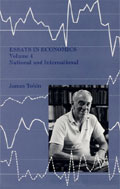Essays in a Keynesian Mode — In a period marked by revisionism in economic theory and retrenchment in the public goals of economic policy, Tobin remains committed to the standard he has upheld throughout his professional life. He is an “eclectic Keynesian” in theory whose socioeconomic concern is to reduce poverty, inequality, and discrimination through the maintenance of full employment and economic growth and through such policies as the negative income tax and other income transfers.
These 28 essays, covering Tobin’s work in macroeconomics from the early 1940s to 1970 are grouped into three parts — macroeconomic theory, economic growth, and money and finance. James Tobin is Sterling Professor of Economics at Yale.
 Volume 2: Consumption and Econometrics
Volume 2: Consumption and Econometrics
MIT Press | July 1987 | ISBN: 0262200643
Volume 2 of James Tobin’s Essays in Economics brings together twenty papers published between 1940 and 1972. These cover macroeconomics, particularly the theory of the relationship between unemployment and inflation and the dilemma their connection poses for policy; consumption function, which is also related to macroeconomic theory and to the theory of individual behavior; consumer theory and statistical method applied to the problem of rationing; and the development and application of econometric methods suitable for the empirical analysis of consumer behavior.
Volume 3: Theory and Policy
MIT Press | 1982 | ISBN: 0262200422
Volume 3 contains a collection of James Tobin’s professional papers contains his most recent work, written mainly since 1974. Essays covers monetary theory and policy, macroeconomic fiscal policies and economic growth, international monetary economies, and welfare and inequality. The book concludes with sketches of other economists Tobin has known — Alvin Hansen, Kermit Gordon, Paul Douglas, Harry Gordon Johnson, Milton Friedman, and John Kenneth Galbraith.
 Volume 4: National and International
Volume 4: National and International
MIT Press | June 1996 | ISBN: 0262201011
This fourth volume in the series of Nobel laureate James Tobin’s classic papers represents his work since 1980. Both national and international views are intermingled among the 36 chapters on macroeconomics and fiscal policy, savings, stabilization policy, international coordination of macroeconomic policy, monetary policy, and exchange rates. Several tributes to colleagues — including Walter Heller and Seymour Harris—round out the collection.